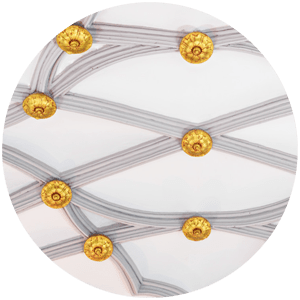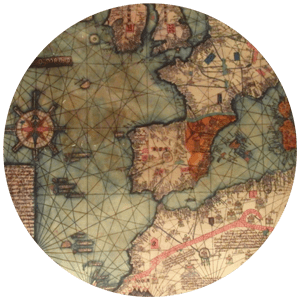We are located in the Renaissance chapel promoted in the middle of 16th century by Archbishop Hernando of Aragon, King Ferdinand the Catholic’s grandson and last archbishop in Zaragoza from Royal Family. This space moves us to Modern Age, when this palace served as a residence for kings during long periods, such as Philip II and Philip IV, in 16th and 17th centuries respectively.
This chapel replaced in functions the chapel commissioned by Archbishop Dalmau de Mur, partially seen in room 2.
At present, this space is referred as “Identitas Room” and shows a permanent exhibition about how history has forged the identity in this territory. Information and images on boards underlie key landmarks and characters in Zaragoza history since it was an Iberian town, called Salduie, 2000 years ago.
Exhibition is completed with an audio-visual named “Strength of a character”, which won the Golden Dolphin in Cannes Corporate Media & TV Awards Event film in 2016, and “Inmortal”, which won the Silver Dauphin and the Black Dolphin at the Cannes Festival 2018, and the Silver Medal to best documentary at the New York Film Festival in 2019.
We are located in the Renaissance chapel promoted in the middle of 16th century by Archbishop Hernando of Aragon, King Ferdinand the Catholic’s grandson and last archbishop in Zaragoza from Royal Family. This space moves us to Modern Age, when this palace served as a residence for kings during long periods, such as Philip II and Philip IV, in 16th and 17th centuries respectively.
This chapel replaced in functions the chapel commissioned by Archbishop Dalmau de Mur, partially seen in room 2.
At present, this space is referred as “Identitas Room” and shows a permanent exhibition about how history has forged the identity in this territory. Information and images on boards underlie key landmarks and characters in Zaragoza history since it was an Iberian town, called Salduie, 2000 years ago.
Exhibition is completed with an audio-visual named “Strength of a character”, which won the Golden Dolphin in Cannes Corporate Media & TV Awards Event film in 2016, and “Inmortal”, which won the Silver Dauphin and the Black Dolphin at the Cannes Festival 2018, and the Silver Medal to best documentary at the New York Film Festival in 2019.

![]()
This room introduces renaissance style which can be appreciated in the starred rib-vault ceiling.
Archbishop Hernando of Aragon was a great Maecenas and one responsible for the introduction of renaissance style in Zaragoza: he proposed la Lonja (market) construction, paid la Seo extension in the middle of 16th century and ordered the Carthusian “Aula Dei” construction.

This room introduces renaissance style which can be appreciated in the starred rib-vault ceiling.
Archbishop Hernando of Aragon was a great Maecenas and one responsible for the introduction of renaissance style in Zaragoza: he proposed la Lonja (market) construction, paid la Seo extension in the middle of 16th century and ordered the Carthusian “Aula Dei” construction.

![]()
Cresques Atlas is one of the most important cartographic maps in the Middle Ages. We see a partial reproduction in this room.
It was made by Majorcan Jewish cartographer and geographer Abraham Cresques, by Prince John’s commission. It was meant to be a present for his cousin, the King of France, Charles IV.
The original map is preserved in the National Library of France in Paris and it is composed of six pages on board, in which the known world is described in the end of 14th century, from a Eurocentric vision.

Cresques Atlas is one of the most important cartographic maps in the Middle Ages. We see a partial reproduction in this room.
It was made by Majorcan Jewish cartographer and geographer Abraham Cresques, by Prince John’s commission. It was meant to be a present for his cousin, the King of France, Charles IV.
The original map is preserved in the National Library of France in Paris and it is composed of six pages on board, in which the known world is described in the end of 14th century, from a Eurocentric vision.
Did you know?…
- To know the receptions space created in renaissance extension in the 16th century by Archbishop Hernando of Aragon, you must go to floor 2.
- Archbishop Hernando of Aragon was a Cistercian monk in the Piedra monastery. The monk, who brought chocolate from America in the middle of 16th century, belonged to this monastery.
Did you know?…
- To know the receptions space created in renaissance extension in the 16th century by Archbishop Hernando of Aragon, you must go to floor 2.
- Archbishop Hernando of Aragon was a Cistercian monk in the Piedra monastery. The monk, who brought chocolate from America in the middle of 16th century, belonged to this monastery.
